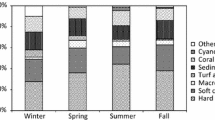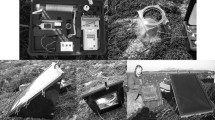Abstract
Respiration and calcification rates of the Pacific oyster Crassostrea gigas were measured in a laboratory experiment in the air and underwater, accounting for seasonal variations and individual size, to estimate the effects of this exotic species on annual carbon budgets in the Bay of Brest, France. Respiration and calcification rates changed significantly with season and size. Mean underwater respiration rates, deducted from changes in dissolved inorganic carbon (DIC), were 11.4 μmol DIC g−1 ash-free dry weight (AFDW) h−1 (standard deviation (SD), 4.6) and 32.3 μmol DIC g−1 AFDW h−1 (SD 4.1) for adults (80–110 mm shell length) and juveniles (30–60 mm), respectively. The mean daily contribution of C. gigas underwater respiration (with 14 h per day of immersion on average) to DIC averaged over the Bay of Brest population was 7.0 mmol DIC m−2 day−1 (SD 8.1). Mean aerial CO2 respiration rate, estimated using an infrared gas analyzer, was 0.7 μmol CO2 g−1 AFDW h−1 (SD 0.1) for adults and 1.1 μmol CO2 g−1 AFDW h−1 (SD 0.2) for juveniles, corresponding to a mean daily contribution of 0.4 mmol CO2 m−2 day−1 (SD 0.50) averaged over the Bay of Brest population (with 10 h per day of emersion on average). Mean CaCO3 uptake rates for adults and juveniles were 4.5 μmol CaCO3 g−1 AFDW h−1 (SD 1.7) and 46.9 μmol CaCO3 g−1 AFDW h−1 (SD 29.2), respectively. The mean daily contribution of net calcification in the Bay of Brest C. gigas population to CO2 fluxes during immersion was estimated to be 2.5 mmol CO2 m−2 day−1 (SD 2.9). Total carbon release by this C. gigas population was 39 g C m−2 year−1 and reached 334 g C m−2 year−1 for densely colonized areas with relative contributions by underwater respiration, net calcification, and aerial respiration of 71%, 25%, and 4%, respectively. These observations emphasize the substantial influence of this invasive species on the carbon cycle, including biogenic carbonate production, in coastal ecosystems.






Similar content being viewed by others
References
Allen, S.M., and L.E. Burnett. 2008. The effects of intertidal air exposure on the respiratory physiology and the killing activity of hemocytes in the pacific oyster, Crassostrea gigas (Thunberg). Journal of Experimental Marine Biology and Ecology 357: 165–171.
Boucher, G., and R. Boucher-Rodoni. 1988. In situ measurement of respiratory metabolism and nitrogen fluxes at the interface of oyster beds. Marine Ecology Progress Series 44: 229–238.
Bougrier, S., P. Geairon, J.M. Deslouspaoli, C. Bacher, and G. Jonquieres. 1995. Allometric relationships and effects of temperature on clearance and oxygene-consumption rates of Crassostrea gigas (Thunberg). Aquaculture 134: 143–154.
Bourget, E., and D.J. Crisp. 1975. Factors affecting deposition of the shell in Balanus balanoides (L.). Journal of the Marine Biological Association of the United Kingdom 55: 231–249.
Brody, S. 1945. Bioenergetics and growth. New York: Reinhold. 1023 pp.
Chauvaud, L., J.K. Thompson, J.E. Cloern, and G. Thouzeau. 2003. Clams as CO2 Generators: The Potamocorbula amurensis example in San Francisco Bay. Limnology and Oceanography 48: 2086–2092.
Clavier, J., M.-D. Castets, T. Bastian, C. Hily, G. Boucher, and L. Chauvaud. 2009. An amphibious mode of life in the intertidal zone: Aerial and underwater contribution of Chthamalus montagui to CO2 fluxes. Marine Ecology Progress Series 375: 185–194.
Davoult, D., J. Harlay, and F. Gentil. 2009. Contribution of a dense population of the brittle star Acrocnida brachiata (Montagu) to the biogeochemical fluxes of CO2 in a temperate coastal ecosystem. Estuaries and Coasts 32: 1103–1110.
Diederich, S., G. Nehls, J.E.E. Van Beusekom, and K. Reise. 2005. Introduced Pacific oysters (Crassostrea gigas) in the northern Wadden Sea: Invasion accelerated by warm summers? Helgoland Marine Research 59: 97–106.
DOE 1994. Handbook of methods for the analysis of the various parameters of the carbon dioxide system in sea water; version 2. eds. A.G. Dickson and C. Goyet. ORNL/CDIAC-74.
Fanslow, D.L., T.F. Nalepa, and T.H. Johengen. 2001. Seasonal changes in the respiratory electron transport system (ETS) and respiration of the zebra mussel, Dreissena polymorpha in Saginaw Bay, Lake Huron. Hydrobiologia 448: 61–70.
Frankignoulle, M., C. Canon, and J.P. Gattuso. 1994. Marine calcification as a source of carbon dioxide: Positive feedback of increasing atmospheric CO2. Limnology and Oceanography 39: 458–462.
Gattuso, J.P., M. Frankignoulle, and R. Wollast. 1998. Carbon and carbonate metabolism in coastal aquatic ecosystems. Annual Review of Ecology and Systematics 29: 405–434.
Gattuso, J.P., M. Frankignoulle, and S.V. Smith. 1999. Measurement of community metabolism and significance in the coral reef CO2 source-sink debate. Proceedings of the National Academy of Sciences of the United States of America 96: 13017–13022.
Gazeau, F., C. Quiblier, J.M. Jansen, J.P. Gattuso, J.J. Middelburg, and C.H.R. Heip. 2007. Impact of elevated CO2 on shellfish calcification. Geophysical Research Letters 34(7): 7603.
Gerdes, D. 1983. The Pacific oyster Crassostrea gigas. Part II. Oxygen consumption of larvae and adults. Aquaculture 31: 221–231.
Gillmor, R.B. 1982. Assessment of intertidal growth and capacity adaptations in suspension-feeding bivalves. Marine Biology 68: 277–286.
Gollety, C., F. Gentil, and D. Davoult. 2008. Secondary production, calcification and CO2 fluxes in the cirripedes Chthamalus montagui and Elminius modestus. Oecologia 155: 133–142.
Grizel, H., and M. Heral. 1991. Introduction into France of the Japanese oyster (Crassostrea gigas). ICES Journal of Marine Science 47: 399–403.
Hamburger, K., F. Mohlenberg, A. Randlov, and H.U. Riisgard. 1983. Size, oxgen-consumption and growth in the mussel Mytilus edulis. Marine Biology 75: 303–306.
Huang, S.C., and R.I.E. Newell. 2002. Seasonal variations in the rates of aquatic and aerial respiration and ammonium excretion of the ribbed mussel, Geukensia demissa (Dillwyn). Journal of Experimental Marine Biology and Ecology 270: 241–255.
Lango-Reynoso, F., N. Devauchelle, M. Le Pennec, and P.J. Hatt. 1999. Elements of reproductive strategy in oysters, Crassostrea gigas, from the “Rade de Brest”, France. Invertebrate Reproduction and Development 36: 141–144.
Lango-Reynoso, F., J. Chávez-Villalba, J.C. Cochard, and M. Le Pennec. 2000. Oocyte size, a means to evaluate the gametogenic development of the Pacific oyster, Crassostrea gigas (Thunberg). Aquaculture 190: 183–199.
Lartaud, F. 2007. Les fluctuations haute fréquence de l'environnement au cours des temps géologiques. Mise au point d'un modèle de référence actuel sur l'enregistrement des contrastes saisonniers dans l'Atlantique nord. Ph.D. Thesis, Université Pierre et Marie Curie (Paris 6).
Lejart, M., and C. Hily. 2005. Proliferation of Crassostrea gigas (Thunberg) in the Bay of Brest: First estimations of the stock and its impact on the global functioning of the ecosystem. 8th International Conference on Shellfish Restoration.
Lejart, M., and C. Hily. 2011. Differential response of benthic macrofauna to the formation of novel oyster reefs (Crassostrea gigas, Thunberg) on soft and rocky substrate in the intertidal of the Bay of Brest, France. Journal of Sea Research 65(1): 84–93.
Lutz, R.A., and D.C. Rhoads. 1977. Anaerobiosis and a theory of growth line formation. Science 198: 1222–1227.
Mann, R. 1979. Some biochemical and physiological aspects of growth and gametogenesis in Crassostrea gigas and Ostrea edulis grown at sustained elevated temperatures. Journal of the Marine Biological Association of the United Kingdom 59: 95–110.
Mantoura, R.F.C., J.M. Martin, and R. Wollast. 1991. Ocean margin processes in global change. Chichester: John Wiley & Sons.
Mao, Y., Y. Zhou, H. Yang, and R. Wang. 2006. Seasonal variation in metabolism of cultured Pacific oyster, Crassostrea gigas. Sanggou Bay, China. Aquaculture 253: 322–333.
Marsden, I.D., and M.A. Weatherhead. 1998. Effects of aerial exposure on oxygen consumption by the New Zealand mussel Perna canaliculus (Gmelin, 1791) from an intertidal habitat. Journal of Experimental Marine Biology and Ecology 230: 15–29.
Martin, S., G. Thouzeau, L. Chauvaud, F. Jean, L. Guerin, and J. Clavier. 2006. Respiration, calcification, and excretion of the invasive slipper limpet, Crepidula fornicata L.: Implications for carbon, carbonate, and nitrogen fluxes in affected areas. Limnology and Oceanography 51: 1996–2007.
Migne, A., D. Davoult, and J.P. Gattuso. 1998. Calcium carbonate production of a dense population of the brittle star Ophiothrix fragilis (Echinodermata: Ophiuroidea): Role in the carbon cycle of a temperate coastal ecosystem. Marine Ecology Progress Series 173: 305–308.
Migne, A., D. Davoult, N. Spilmont, D. Menu, G. Boucher, J.-P. Gattuso, and H. Rybarczyk. 2002. A closed-chamber CO2 flux method for estimating primary production and respiration in emersed conditions. Marine Biology 140: 865–869.
Ni Longphuirt, S., J. Clavier, J. Grall, L. Chauvaud, F. Le Loc'h, I. Le Berre, J. Flye-Sainte-Marie, J. Richard, and A. Leynaert. 2007. Primary production and spatial distribution of subtidal microphytobenthos in a temperate coastal system, the Bay of Brest. Estuarine Coastal and Shelf Science 74: 367–380.
Pierrot, D., E. Lewis, and D.W.R. Wallace. 2006. MS Excel Program developed for CO2 system calculations. Carbon Dioxide Information Analysis Center, Oak Ridge National Laboratory, U.S. Department of Energy, Oak Ridge, Tennessee.
Ren, J.S., A.H. Ross, and D.R. Schiel. 2000. Functional descriptions of feeding and energetics of the Pacific oyster Crassostrea gigas in New Zealand. Marine Ecology Progress Series 208: 119–130.
Roy, R.N., L.N. Roy, K.M. Vogel, C. Porter-Moore, T. Pearson, C.E. Good, F.J. Millero, and D.M. Campbell. 1993. The dissociation constants of carbonic acid in seawater at salinities 5 to 45 and temperatures 0 to 45°C. Marine Chemistry 44: 249–267.
Sabine, C.L., R.A. Feely, N. Gruber, R.M. Key, K. Lee, J.L. Bullister, R. Wanninkhof, C.S. Wong, D.W.R. Wallace, B. Tilbrook, T.-H. Peng, A. Kozyr, T. Ono, and A.F. Rios. 2004. The oceanic sink for anthropogenic CO2. Science 305: 367–371.
Saucedo, P.E., L. Ocampo, M. Monteforte, and H. Bervera. 2004. Effect of temperature on oxygen consumption and ammonia excretion in the Calafia mother-of-pearl oyster, Pinctada mazatlanica (Hanley, 1856). Aquaculture 229: 377–387.
Saulquin, B., and F. Gohin. 2010. Mean seasonal cycle and evolution of the sea surface temperature from satellite and in situ data in the English Channel for the period 1986–2006. International Journal of Remote Sensing 31–15: 4069–4093.
Scherrer, B. 1984. Biostatistique. Montreal: Gaetan Morin.
Simpfendorfer, R.W., M.V. Vial, D.A. Lopez, M. Verdala, and M.L. Gonzalez. 1995. Relationship between the aerobic and anaerobic metabolic capacities and the vertical-distribution of 3 intertidal sessile invertebrates—Jehlius cirratus (Darwin) (Cirripedia), Perumytilus purpuratus (Lamarck) (Bivalvia) and Mytilus chilensis (Hupe) (Bivalvia). Comparative Biochemistry and Physiology B-Biochemistry and Molecular Biology 111: 615–623.
Smith, S.V., and G.S. Key. 1975. Carbon dioxide and metabolism in marine environments. Limnology and Oceanography 20: 493–495.
Sokal, R.R., and F.J. Rohlf. 1981. Biometry. New York: Freeman and Company.
Sukhotin, A.A., and H.O. Portner. 2001. Age-dependence of metabolism in mussels Mytilus edulis (L.) from the White Sea. Journal of Experimental Marine Biology and Ecology 257: 53–72.
Sukhotin, A.A., D.L. Lajus, and P.A. Lesin. 2003. Influence of age and size on pumping activity and stress resistance in the marine bivalve Mytilus edulis L. Journal of Experimental Marine Biology and Ecology 284: 129–144.
Suykens, K., S. Schmidt, B. Delille, J. Harlay, L. Chou, C. De Bodt, N. Fagel, and A.V. Borges. 2011. Benthic remineralization in the northwest European continental margin (northern Bay of Biscay). Continental Shelf Research 31: 644–658.
Walne, P.R., and R. Mann. 1975. Growth and biochemical composition in Ostrea edulis and Crassostrea gigas. In 9th European Marine Biology Symposium, ed. H. Barnes, 587–607. Scotland: Aberdeen Univ. Press.
Willson, L.L., and L.E. Burnett. 2000. Whole animal and gill tissue oxygen uptake in the Eastern oyster, Crassostrea virginica: Effects of hypoxia, hypercapnia, air exposure, and infection with the protozoan parasite Perkinsus marinus. Journal of Experimental Marine Biology and Ecology 246: 223–240.
Wolf-Gladrow, D.A., U. Riebesell, S. Burkhardt, and J. Bijma. 1997. Direct effects of CO2 concentration on growth and isotopic composition of marine plankton. 5th International CO 2 Conference, Cairns, Australia, 461–476.
Acknowledgments
This study was supported by the “Région Bretagne” and the “Ministère de l”Ecologie et du Développement durable'. We are grateful to the SOMLIT (Service d'Observation en Milieu LITtoral, INSU-CNRS) group for providing data from the MAREL Iroise station. We acknowledge S. Thomas and three anonymous reviewers for their constructive comments and suggestions that greatly improved this manuscript.
Author information
Authors and Affiliations
Corresponding author
Rights and permissions
About this article
Cite this article
Lejart, M., Clavier, J., Chauvaud, L. et al. Respiration and Calcification of Crassostrea gigas: Contribution of an Intertidal Invasive Species to Coastal Ecosystem CO2 Fluxes. Estuaries and Coasts 35, 622–632 (2012). https://doi.org/10.1007/s12237-011-9462-y
Received:
Accepted:
Published:
Issue Date:
DOI: https://doi.org/10.1007/s12237-011-9462-y




